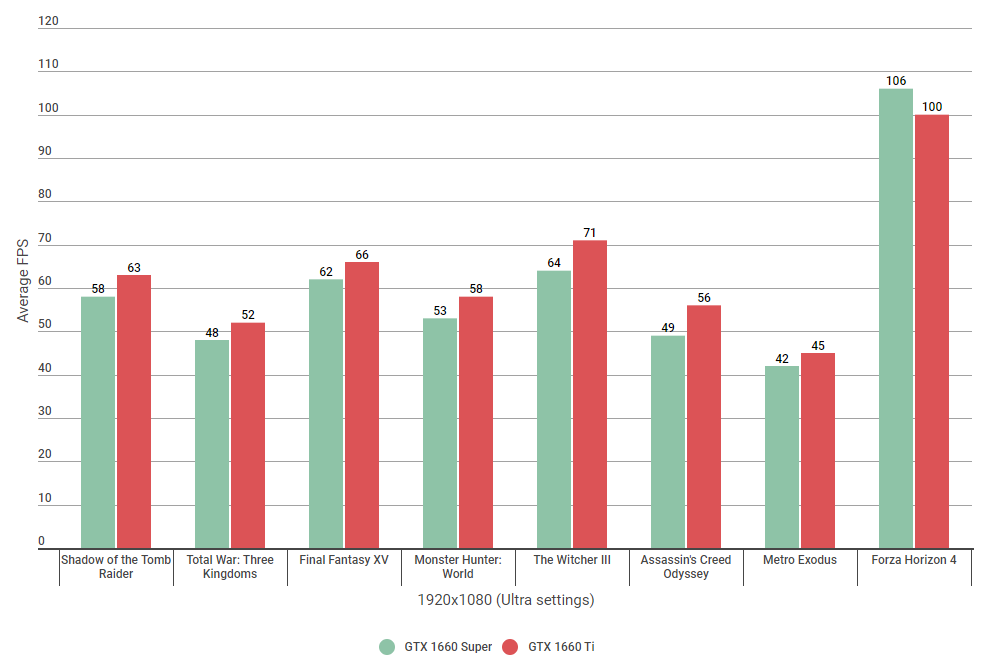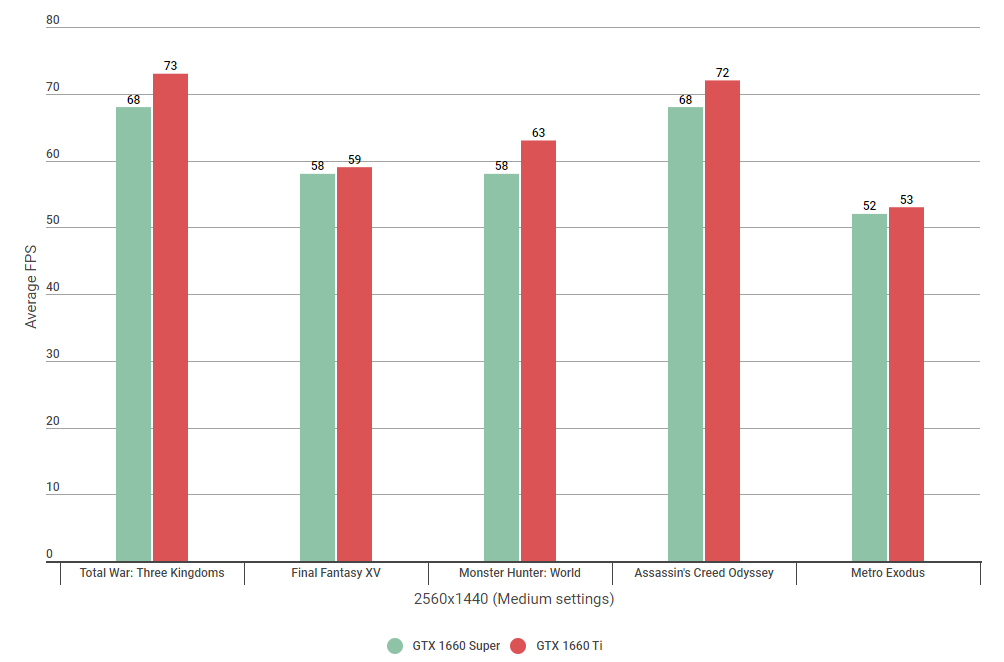Nvidia GTX 1660 Super vs 1660 Ti: Which is best?
And which one should you buy?
Nvidia's GeForce GTX 1660 Super is in a bit of an odd place right now. It's a teensy bit faster than its non-Super sibling, the regular old GTX 1660, but not quite fast enough to really a proper impact on your minute-to-minute gaming performance. But given the GTX 1660 was already pretty close in speed to its more expensive cousin, the GTX 1660 Ti, is the GTX 1660 Super actually a way of getting Ti levels of power on the cheap? I've made some lovely bar graphs to find out.
Nvidia GTX 1660 Super vs 1660 Ti: How we test
Just like my GTX 1660 vs 1660 Super comparison piece, the main thing I want to find out here is how well each card runs at a variety of resolutions and graphics settings. Also like that particular test, I've only focused on 1920x1080 and 2560x1440 resolutions this time round, because, let's face it, these cards are in no way intended to be 4K GPUs. As such, I haven’t included any 4K results here.
To test each card, I paired them with my Intel Core i5-8600K CPU and 16GB of Corsair Vengeance 2133MHz RAM and put them through my general benchmarking suite, taking an average frame rate from either their own built-in benchmarking tools or from my own repeated manual gameplay tests. The games include Shadow of the Tomb Raider, Total War: Three Kingdoms, Assassin’s Creed Odyssey, Metro Exodus, The Witcher III, Final Fantasy XV, Monster Hunter: World and Forza Horizon 4.
For this particular test, I've used Zotac's GeForce GTX 1660 Super Twin Fan and Asus GeForce GTX 1660 Ti Phoenix cards, as these were the ones sent to me for review. Both cards are at the cheaper end of their respective categories, and I left both of them running at their stock reference speeds. As a result, they should be fairly representative of their respective families, but you may find more expensive cards achieve ever so slightly faster results than what I've detailed below. But enough preamble chat. Let's get to those lovely charts.
Nvidia GTX 1660 Super vs 1660 Ti: 1080p benchmarks
Right now, the GTX 1660 Ti is my top 1080p gaphic card recommendation, while the regular GTX 1660 is the card I reckon 'you should actually buy' if you're less fussed about playing at 60fps on max settings. That's because the GTX 1660 can still hit 60fps on High settings in pretty much every one of today's big blockbuster games, which is great if you're looking to save a bit of cash. The GTX 1660 Ti, meanwhile, is much better equipped for dealing with those higher quality settings.
Compared with the GTX 1660 Super, the 1660 Ti is still the faster card overall, but as you can see below, the 1660 Super does come pretty close to hitting 60fps on Ultra settings in a surprisingly high number of cases. In fact, it even pips the 1660 Ti to the post in Forza Horizon 4, claiming 1st place with an average of 106fps compared to just 100fps.
What's more, the differences between some of these frame rates are actually pretty small. For instance, I'm not sure I'd be able to tell the difference between, say, 48fps and 52fps in Total War: Three Kingdoms, nor would I be able to tell if the Super's average of 42fps in Metro Exodus was necessarily smoother than the Ti's 45fps average. Similarly, anyone with a regular 60Hz monitor isn't going to appreciate being able to run Final Fantasy XV at an average of 66fps compared to 62fps, for example, and I'm pretty confident Shadow of the Tomb Raider's performance will look and feel pretty much identical, too.
In this light, then, the GTX 1660 Super does seem like a pretty decent way of getting near-Ti levels of power on the cheap, which is only hammered home further when we move the quality setting down to High. Here, we're into high refresh rate territory for both cards pretty much (apart from old Metro Exodus, that is), and once again I don't think any human eyeball is going to be able to tell the difference between 70fps or 75fps in their minute-to-minute gameplay.
As a 1080p card, then, the GTX 1660 Super has a fair amount to recommend it compared to its more expensive Ti counterpart, which at time of writing currently goes for around £250 / $260. The GTX 1660 Super, on the other hand, can be had for £220 / $230.
Nvidia GTX 1660 Super vs 1660 Ti: 1440p benchmarks
However, I think the GTX 1660 Ti's additional £30 / $30 or so is probably worth the extra money when you consider each card's 1440p performance. Again, the GTX 1660 Ti isn't really an Ultra-grade graphics card at this resolution, but that extra 5-7fps or so you get from games such as The Witcher III and Monster Hunter: World are just about big enough to register. After all, when you're dealing with that sensitive 35-50fps zone, even small jumps in performance can have a noticeable impact on your overall perception of the game's speed. Elsewhere, of course, a gap of 1-3fps isn't going to make a huge amount of difference.
However, High is where the GTX 1660 Ti has always been most comfortable at this resolution (which is why it's also the card I think you 'should actually buy' for 1440p), and I think it still maintains enough of a lead here to warrant spending just that little bit extra.
After all, it maintains that sizeable performance boost in both Monster Hunter: World and The Witcher III, and there was enough of a jump in Final Fantasy XV as well for me to say the GTX 1660 Ti was noticeably better. Indeed, whereas the Super dipped as low as 41fps in FFXV on High, the 1660 Ti never went below 46fps, making it feel smoother overall.
That gap did start to close when I moved down to Medium settings, admittedly, with both cards effectively levelling out in Final Fantasy XV as well as Metro Exodus, but having spent a good amount of time playing the former, I would rather suffer a slightly lower frame rate and play FFXV on High than settle for near-60fps on its Average quality setting. That's just my own personal preference, of course, and there will no doubt be some of you who don't think that extra £30 / $30 is really worth it at this resolution.
And that's fine. However, when it comes to future-proofing your PC, I reckon the GTX 1660 Ti is still the card to buy. It may not be that much faster than the GTX 1660 Super right now, but as games start to get more and more demanding, it's the Ti, not the Super, that's going to be the card that lets you keep gaming at those higher quality settings for longer.
Nvidia GTX 1660 Super vs 1660 Ti: Conclusion
Overall, then, the GTX 1660 Ti is still the best GPU in the 1660 family, and personally I still think it offers the best balance of 1080p and 1440p gaming. However, the more budget conscious among you will probably be just as happy going with the GTX 1660 Super instead, although that then raises questions about whether it's really worth opting for in the face of the (soon to be even cheaper) regular GTX 1660. To see how the Super compares to its non-Super sibling in more detail, head on over in my GTX 1660 vs 1660 Super comparison piece.
In all honesty, though, now isn't really the best time to be buying a new graphics card full stop. With Black Friday just around the corner, not to mention that imminent GTX 1660 price cut, the cost of 1080p graphics cards are likely to fluctuate all over the shop in the coming weeks, so if you can afford to do so I'd strongly recommend waiting to see what kind of deal you can bag in during Black Friday. Besides, even if the freshly launched GTX 1660 Super doesn't change price over the Black Friday period, it's more than likely that the now eight-month-old GTX 1660 Ti will, simply by virtue of being older. So watch this space, deals fiends, because the bargains are a'coming.







